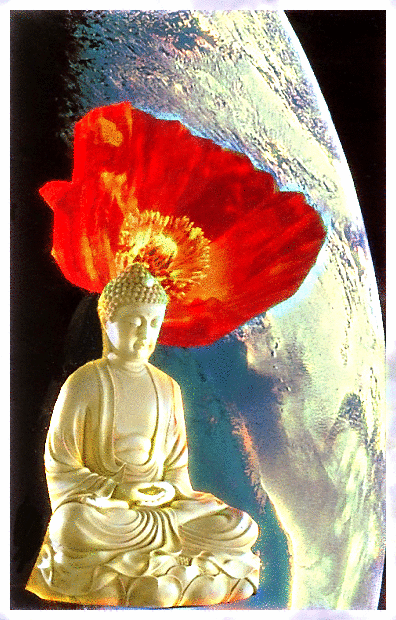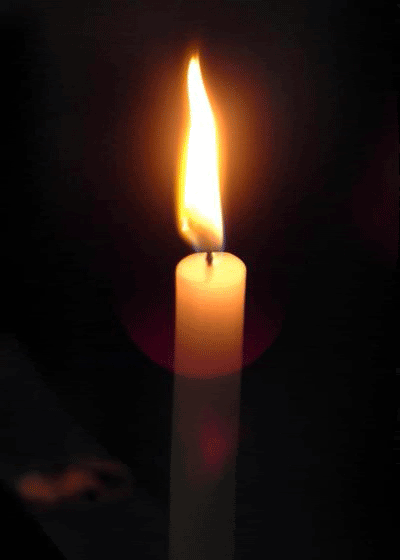05/30/13
Filed under:
General
Posted by:
site admin @ 6:43 pm
936 LESSON 31-05-2013 FRIDAY-FREE ONLINE eNālāndā Research and Practice UNIVERSITY
from FREE ONLINE eNālāndā Research and
Practice UNIVERSITY through http://sarvajan.ambedkar.org


TIPITAKA-ஸுத்தபிடக-Section-A
TIPITAKA
TIPITAKA AND TWELVE DIVISIONS
Brief historical background
Sutta Pitaka
Vinaya Pitaka
Abhidhamma Pitaka
Twelve Divisions of Buddhist Canons
Nine Divisions of Buddhist Canons
 through http://sarvajan.ambedkar.org
through http://sarvajan.ambedkar.org
TO





The Clear White Light

>>ஸுத்தபிடக-திக்க நிகாய-Iமெய்யார்வ தியானம் -A. உள்ளுயிர்ப்பு மற்றும் சுவாசித்தல் பிரிவு Sutta Piṭaka >> Digha Nikāya-I. Kāyānupassanā -A. Section on ānāpāna
தமிழ்
நான் இவ்வாறு கேட்டிருக்கேன்:
ஒரு
குறிப்பிட்டதறுவாயில், ஒரு கடைத்தெருவு நகரமான Kammāsadhamma
(கம்மாசதம்மா) வில், Kurus (பாரத்துவாசர்) இடையில் Bhagavā (பகவான்) தங்கி
இருந்தார்.
அவ்விடம், பிக்குக்களுக்கு அவர் உரை நிகழ்த்தினார்:
- பிக்குக்களுக்களா
- பிக்குக்களுக்கு Bhaddante (பந்த்தே) பதில் அளித்தார்.Bhagavā (பகவா) சொற்றார்:
-
இது, பிக்குக்களுக்களா,ஒன்றுமில்லை இனங்களை தூய்மைப்படுத்தும் பாதையில்
நடத்திச் செல்லும், துயரம் மற்றும் புலம்பலை முறியடித்து,
dukkha-domanassa(துக்கம்-துயரம்)மறைவு , Nibbāna(யாவுங் கடந்த நிலை
உணர்தல்) மெய்யாகக் காண்டல்,அதுதான் நான்கு பொருள்கள் கொண்ட
satipaṭṭhānas(விழிப்பு நிலை உளதாந்தன்மை) என கூறலாம்.
மற்றும் எப்படி,பிக்குக்களுக்களே,kāya in kāya (உடலில்
உடலை கவனித்து வசிக்கிரார்? இங்கு பிக்குக்களுக்களா,ஒரு
பிக்கு,காட்டுக்குச் சென்றோ அல்லது மரத்தடிக்குச் சென்றோ அல்லது காலி
அறைகுச் சென்றோ,காலை குறுக்காக கீழ்நோக்கி மடித்துக்கொண்டு அமர்கிரார்,உடலை
செங்குத்தாக சரிசெய்துக்கொண்டு,மற்றும் sati parimukhaṃ. மூச்சு உள்ளே
அல்லது வெளியே சரிசெய்துக்கொள்கிரார். sato இவ்வாறு கவனமான மூச்சு உள்ளே
அல்லது வெளியே செலுத்துகிரார். மூச்சு நீண்டதாக உள்ளே செலுத்தும்போது: நான்
நீண்டதாக உள்ளே செலுத்துககின்றேன் என அறிகிரார்.மூச்சு நீண்டதாக வெளியே
செலுத்தும்போது: நான் நீண்டதாக வெளியே செலுத்துககின்றேன் என
அறிகிரார்.மூச்சு குறைவாக உள்ளே செலுத்தும்போது: நான் குறைவாக உள்ளே
செலுத்துககின்றேன் என அறிகிரார்.மூச்சு குறைவாக வெளியே செலுத்தும்போது:நான்
குறைவாக வெளியே செலுத்துககின்றேன் என அறிகிரார்.அவர் தானே
பயிற்சித்துகொள்கிரார்: முழு kāya உடலை/காயாவையும் கூருணர்ச்சியுடன்,நான்
மூச்சை உள்ளே செலுத்துககின்றேன்:அவர் தானே பயிற்சித்துகொள்கிரார்:முழு
kāya உடலை/காயாவையும் கூருணர்ச்சியுடன்,நான் மூச்சை வெளியே
செலுத்துககின்றேன்:அவர் தானே பயிற்சித்துகொள்கிரார்: kāya-saṅkhāras
உடல்/காயா இச்சாசத்தியை அமைதி உண்டாக்கொண்டு.நான் மூச்சை உள்ளே
செலுத்துககின்றேன்:அவர் தானே பயிற்சித்துகொள்கிரார்:,நான் மூச்சை வெளியே
செலுத்துககின்றேன்:அவர் தானே பயிற்சித்துகொள்கிரார்:
சம்மதம்படி,பிக்குக்களுக்களே,திறமை கடைசல்காரர்
அல்லது கடைசல்காரின் தொழில் பழகுநர், ஒரு நீளமான சுழற்றுதல் உருவாக்குதல்
குறிப்பறிது: ‘நான் நீளமான சுழற்றுதல் உருவாக்குகிறேன்’;ஒரு குறைவான
சுழற்றுதல் உருவாக்குதல் குறிப்பறிது: ‘நான் குறைவான சுழற்றுதல்
உருவாக்குகிறேன்’;அவ்வழி,பிக்குக்களுக்களே,ஒரு பிக்கு,மூச்சு நீண்டதாக
உள்ளே செலுத்தும்போது: நான் நீண்டதாக உள்ளே செலுத்துககின்றேன் என
அறிகிரார்.மூச்சு நீண்டதாக வெளியே செலுத்தும்போது: நான் நீண்டதாக வெளியே
செலுத்துககின்றேன் என அறிகிரார்.மூச்சு குறைவாக உள்ளே செலுத்தும்போது: நான்
குறைவாக உள்ளே செலுத்துககின்றேன் என அறிகிரார்.மூச்சு குறைவாக வெளியே
செலுத்தும்போது:நான் குறைவாக வெளியே செலுத்துககின்றேன் என அறிகிரார்.அவர்
தானே பயிற்சித்துகொள்கிரார்: முழு kāya உடலை/காயாவையும்
கூருணர்ச்சியுடன்,நான் மூச்சை உள்ளே செலுத்துககின்றேன்:அவர் தானே
பயிற்சித்துகொள்கிரார்:முழு kāya உடலை/காயாவையும் கூருணர்ச்சியுடன்,நான்
மூச்சை வெளியே செலுத்துககின்றேன்:அவர் தானே பயிற்சித்துகொள்கிரார்:
kāya-saṅkhāras உடல்/காயா இச்சாசத்தியை அமைதி உண்டாக்கொண்டு.நான் மூச்சை
உள்ளே செலுத்துககின்றேன்:அவர் தானே பயிற்சித்துகொள்கிரார்:,நான் மூச்சை
வெளியே செலுத்துககின்றேன்:அவர் தானே பயிற்சித்துகொள்கிரார்:
இவ்வாறு
அவர் kāya in kāya உடல்/காயத்தை காயதுக்குள் கண்காணி வாசம் செய்கிரார்,
அல்லது காயத்தை காயதுக்கு வெளியே கண்காணி வாசம் செய்கிரார், அல்லது காயத்தை
காயதுக்கு உள்ளே மற்றும் வெளியே கண்காணி வாசம் செய்கிரார்;புலன்களால்
உணரத்தக்க எழுச்சி கண்காணி வாசம் செய்கிரார், மற்றும் புலன்களால்
உணரத்தக்கதை கடந்துசெல்லுவதை கண்காணித்து வாசம் செய்கிரார்; இல்லாவிடில்
எச்சரிக்கையாயிருக்கிற உணர் உடனிருக்கிறதை,சும்மா வெறும் ஓர்அளவு ஞானம்
மற்றும் ஓர்அளவு paṭissati என எண்ணி பற்றறு வாசம் செய்கிரார்.
பாளி
Katha·ñ·ca,
bhikkhave, bhikkhu kāye kāyānupassī viharati? Idha, bhikkhave, bhikkhu
arañña-gato vā rukkha-mūla-gato vā suññ’āgāra-gato vā nisīdati pallaṅkaṃ
ābhujitvā ujuṃ kāyaṃ paṇidhāya parimukhaṃ satiṃ upaṭṭhapetvā. So
sato’va assasati, sato’va passasati. Dīghaṃ vā assasanto ‘dīghaṃ
assasāmī’ ti pajānāti; dīghaṃ vā passasanto ‘dīghaṃ passasāmī’ ti
pajānāti; rassaṃ vā assasanto ‘rassaṃ assasāmī’ ti pajānāti; rassaṃ vā
passasanto ‘rassaṃ passasāmī’ ti pajānāti; ’sabba-kāya-paṭisaṃvedī
assasissāmī’ ti sikkhati; ’sabba-kāya-paṭisaṃvedī passasissāmī’ ti
sikkhati; ‘passambhayaṃ kāya-saṅkhāraṃ assasissāmī’ ti sikkhati;
‘passambhayaṃ kāya-saṅkhāraṃ passasissāmī’ ti sikkhati.
Seyyathāpi,
bhikkhave, dakkho bhamakāro vā bhamakār·antevāsī vā dīghaṃ vā añchanto
‘dīghaṃ añchāmī’ ti pajānāti; rassaṃ vā añchanto ‘rassaṃ añchāmī’ ti
pajānāti; evameva kho, bhikkhave, bhikkhu dīghaṃ vā assasanto ‘dīghaṃ
assasāmī’ ti pajānāti; dīghaṃ vā passasanto ‘dīghaṃ passasāmī’ ti
pajānāti; rassaṃ vā assasanto ‘rassaṃ assasāmī’ ti pajānāti; rassaṃ vā
passasanto ‘rassaṃ passasāmī’ ti pajānāti; ’sabba-kāya-paṭisaṃvedī
assasissāmī’ ti sikkhati; ’sabba-kāya-paṭisaṃvedī passasissāmī’ ti
sikkhati; ‘passambhayaṃ kāya-saṅkhāraṃ assasissāmī’ ti sikkhati;
‘passambhayaṃ kāya-saṅkhāraṃ passasissāmī’ ti sikkhati.
Iti ajjhattaṃ vā kāye
kāyānupassī viharati, bahiddhā vā kāye kāyānupassī viharati,
ajjhatta-bahiddhā vā kāye kāyānupassī viharati; samudaya-dhamm·ānupassī
vā kāyasmiṃ viharati, vaya-dhamm·ānupassī vā kāyasmiṃ viharati,
samudaya-vaya-dhamm·ānupassī vā kāyasmiṃ viharati; ‘atthi kāyo’ ti vā
pan·assa sati paccupaṭṭhitā hoti, yāvadeva ñāṇa·mattāya
paṭissati·mattāya,{1} a·nissito ca viharati, na ca kiñci loke upādiyati.
Evam·pi kho, bhikkhave, bhikkhu kāye kāyānupassī viharati.
English
Introduction
I. Observation of Kāya
I.Fixing the attention, earnest meditation
A. Section on ānāpāna
A.Section on the Basis of action. This term is applied to certain
religious exercises or meditations, by means of which samādhi, jhāna and
the four Paths are attained. Each of these is based on a certain
formula or rite, also called kammaṭṭhānaṃ
B. Section on postures
B.Section on Way of deportment. There are four iriyāpathas or postures, viz. walking, standing sitting, lying down.
C. Section on sampajañña
C.Section on Knowing, understanding, conscious.
D. Section on repulsiveness
D.Section on To expect, await, desire
E. Section on the Elements
E.Section on Primary or elementary substance; principle, element,
material; a property of a primary substance, as colour, taste, sound; an
organ of sense; a bodily principle or humour of which there are three,
phlegm, wind and bile; a constituent of the body, as flesh, blood,
bones; the remains of a body after cremation; a sacred relic; a fossil; a
metal
F. Section on the nine charnel grounds
II. Observation of Vedanā
III. Observation of Citta
IV. Observation of Dhammas
A. Section on the Nīvaraṇas
B. Section on the Khandhas
C. Section on the Sense Spheres
D. Section on the Bojjhaṅgas
E. Section on the Truths
E1. Exposition of Dukkhasacca
E2. Exposition of Samudayasacca
E3. Exposition of Nirodhasacca
E4. Exposition of Maggasacca
Introduction
Thus have I heard:
On one occasion, the Bhagavā was staying among the Kurus at Kammāsadhamma, a market town of the Kurus. There, he addressed the bhikkhus:
– Bhikkhus.
– Bhaddante answered the bhikkhus. The Bhagavā said:
–
This, bhikkhus, is the path that leads to nothing but the purification
of beings, the overcoming of sorrow and lamentation, the disappearance
of dukkha-domanassa ( Cessation of suffering- Nibbaṇa (Ultimate goal for eternal bliss), the attainment of the right way, the realization of Nibbāna (Ultimate goal for eternal bliss), that is to say the four satipaṭṭhānas(Fixing the attention, earnest meditation).
Which four? Here, bhikkhus, a bhikkhu dwells observing kāya in kāya (the body in the threshold of the body), ātāpī sampajāno (Ardent/ zealous/ strenuous/ active Knowing/ understanding conscious) satimā (Of retentive memory or active mind/ thoughtful/ reflecting) having given up abhijjhā-domanassa (Covetousness) towards the world. He dwells observing vedanā in vedanā (Feeling/ sensation/ perception; pain/suffering in threshold of Feeling/ sensation/ perception; pain/suffering) ātāpī sampajāno( Ardent/ zealous/ strenuous/ active Knowing/ understanding conscious), satimā(Of retentive memory or active mind/ thoughtful/ reflecting), having given up abhijjhā-domanassa ( Covetousness) towards the world. He dwells observing citta in citta (The heart; the mind; a thought, an idea; will/ intention in threshold of The heart; the mind; a thought, an idea; will/ intention), ātāpī sampajāno (Ardent/ zealous/ strenuous/ active Knowing/ understanding conscious), satimā (Of retentive memory or active mind/ thoughtful/ reflecting), having given up abhijjhā-domanassa (Covetousness) towards the world. He dwells observing dhamma·s in dhamma·s (and (dhammaṃ)Nature/ condition/ quality/ property/
characteristic; function/ practice/ duty; object/ thing/ idea/
phenomenon; doctrine; law; virtue/ piety; justice; the law or Truth of
the Buddha; the Buddhist scriptures; religion in threshold of and (dhammaṃ)Nature/ condition/ quality/ property/
characteristic; function/ practice/ duty; object/ thing/ idea/
phenomenon; doctrine; law; virtue/ piety; justice; the law or Truth of
the Buddha; the Buddhist scriptures; religion) ātāpī sampajāno (Ardent/ zealous/ strenuous/ active Knowing/ understanding conscious), satimā (Of retentive memory or active mind/ thoughtful/ reflecting), having given up abhijjhā-domanassa (Covetousness) towards the world.
I. Kāyānupassanā (Fixing the attention, earnest meditation)
A. Section on ānāpāna ( Inhaled and exhaled breath, inspiration and respiration) (Basis of action. This term is applied to certain
religious exercises or meditations, by means of which samādhi (Agreement, peace, reconciliation; tranquillity, self-concentration, calm), jhāna (Meditation, contemplation; religious meditation or abstraction of the mind, mystic or abstract meditation, ecstasy, trance) and
the four Paths are attained. Each of these is based on a certain
formula or rite, also called kammaṭṭhānaṃ)
And how, bhikkhus, does a bhikkhu dwell observing kāya in kāya
(the body in the threshold of the body)? Here, bhikkhus, a
bhikkhu, having gone to the forest or having gone at the root of a tree
or having gone to an empty room, sits down folding the legs crosswise,
setting kāya (body) upright, and setting sati parimukhaṃ (Recollection; active state of mind, fixing the mind
strongly upon any subject, attention, attentiveness, thought,
reflection, consciousness In front, before). Being
thus sato (Recollecting, mindful, attentive, thoughtful, conscious)he breathes in, being thus sato (Recollecting, mindful, attentive, thoughtful, conscious) he breathes out. Breathing in
long he understands: ‘I am breathing in long’; breathing out long he
understands: ‘I am breathing out long’; breathing in short he
understands: ‘I am breathing in short’; breathing out short he
understands: ‘I am breathing out short’; he
trains himself: ‘feeling the whole kāya (body), I will breathe in’; he trains
himself: ‘feeling the whole kāya (body), I will breathe out’; he trains
himself: ‘calming down the kāya-saṅkhāras (refering to body Constructing, preparing, perfecting, embellishing; aggregation; matter; karma ( Hail) ; the skandhas (own) , I will breathe in’; he trains
himself: ‘calming down the kāya-saṅkhāras (refering to body Constructing, preparing, perfecting, embellishing; aggregation; matter; karma ( Hail) ; the skandhas (own), I will breathe out’.
Just as, bhikkhus, a skillful turner or a turner’s apprentice, making a
long turn, understands: ‘I am making a long turn’; making a short turn,
he understands: ‘I am making a short turn’; in the same way, bhikkhus, a
bhikkhu, breathing in long, understands: ‘I am breathing in long’;
breathing out long he understands: ‘I am breathing out long’; breathing
in short he understands: ‘I am breathing in short’; breathing out short
he understands: ‘I am breathing out short’; he
trains himself: ‘feeling the whole kāya (body), I will breathe in’; he trains
himself: ‘feeling the whole kāya (body), I will breathe out’; he trains
himself: ‘calming down the kāya-saṅkhāras (refering to body Constructing, preparing, perfecting, embellishing; aggregation; matter; karma ( Hail) ; the skandhas (own), I will breathe in’; he trains
himself: ‘calming down the kāya-saṅkhāras (refering to body Constructing, preparing, perfecting, embellishing; aggregation; matter; karma ( Hail) ; the skandhas (own), I will breathe out’.
Thus he dwells observing kāya in kāya (the body in the threshold of the body) internally, or he dwells observing kāya in kāya (the body in the threshold of the body) externally, or he dwells observing kāya in kāya (the body in the threshold of the body) internally and externally; he dwells observing the samudaya (Rise, origin, commencement; origination, cause; multitude) of phenomena (sapindus detergens)in kāya (body), or he dwells observing the passing away of phenomena in kāya, or he dwells observing the samudaya and passing away of phenomena (sapindus detergens) in kāya (body); or else, [realizing:] “this is kāya!” sati is present in him, just to the extent of mere ñāṇa and mere paṭissati, he dwells detached, and does not cling to anything in the world. Thus, bhikkhus, a bhikkhu dwells observing kāya in kāya (the body in the threshold of the body).
http://thehamiltonproject.blogspot.in/2011/12/yogi-toobox-anapanasati-sutta.html
Lately, I have
returned to basics and have seen great things result from simply
following the Buddha’s anapana instructions found in the anapanasati sutta.
If practiced to the tee, the anapanasati instructions lead in sequence
to the cultivation of the very factors that come together to fabricate
the sutta style full bodied 100% sensuous 1st rupa jhana and beyond.
Here is the lowdown of how I am currently putting these instructions into action to great effect.
In
the initial instructions the Buddha talks of, notice that he gives a
secondary object/objective along with observing the incoming and
outgoing breath.
“1) Breathing
in long, he discerns, ‘I am breathing in long’; or breathing out long,
he discerns, ‘I am breathing out long.’ Or breathing in short, he
discerns, ‘I am breathing in short’; or breathing out short, he
discerns, ‘I am breathing out short.’ 2)
He trains himself, ‘I will breathe in sensitive to the entire body.’ He
trains himself, ‘I will breathe out sensitive to the entire body.’ 3)
He trains himself, ‘I will breathe in calming bodily fabrication.’ He
trains himself, ‘I will breathe out calming bodily fabrication.”
1)
Notice the first step is to observe the incoming and outgoing breath
discerning its length at the same time. One is not simply staring at the
breath but taking on board a secondary object/objective such as
discerning the length of the breath each time it comes in and out. One
can experiment with just staring at the breath VERSUS staring at it but
also actively discerning the length of it each time it goes in and out.
Notice a difference?
One
is directing thought towards discerning whether the breath is long ,
longer than before, short, shorter than before, becoming sensitive to
the whole body etc etc. Having this secondary object/objective will take
up more of the brain’s capacity so there will be less space to wander.
This
relates to something Tarin of the DhO has written about before. One
engages the mind’s proliferating tendency by giving it more things to
pay attention to as opposed to just the breath. Thus taking on the
secondary object/objective the Buddha gives along with the breath will
engage this very proliferating tendency:
“What
I mean by ‘the sense of seeing’ is, literally, what it is to experience
seeing directly; to perceive is to be engaged in a lively activity and
is what is meant by paying attention. Yet, such attention is likely to
tend toward proliferating stories and fabrications, from persistent
reflection and mental commentary on one hand (when concentration is weak
and/or scattered) to outright hallucination on the other (when
concentration is powerful and/or focused). Those proliferations are to
be avoided. How may these proliferations be avoided? By otherwise
engaging the proliferating tendency. How may the proliferating tendency
be otherwise engaged? By applying the mind further. To what further
apply the mind? To the apprehension (of more) of what is happening. What
more is happening (that is not yet engaged)? The apprehension of (the
apprehension of) perception itself.
To
apprehend perception directly is necessarily also to apprehend that
apprehension is occurring, and to experience in such a manner is to
experience cleanly and clearly, entirely engagedly and encompassedly,
incuding the bodily sense of such experience. To see not just what the
eye sees but what it is to see is therefore to see cleanly and clearly,
entirely engagedly and encompassedly, including the bodily sense of such
seeing. Seeing in this manner engages the energies which otherwise fuel
the proliferating tendency, and so avoids such proliferation. Further,
experiencing seeing as a bodily sense leads to deeper insight into what
the body is, and what perceiving is.”
NOTE:
A yogi should spend enough time on each secondary object/objective
until one is able to follow the instructions without much mind wandering
and distraction. If a whole formal sit is spent on just the 1st
instruction, all the better to master each part before moving onto the
next part.
2)
The Buddha goes onto give more secondary objects/objectives in
sequential order. Once one has mastered somewhat the discernment of the
length of the incoming and outgoing breath without being pulled here and
there by a wandering mind one can then proceed to the next step:
Becoming sensitive to the entire body.
There
are a couple of interpretations of what ‘entire body’ is meant to be.
One interpretation is that it is the ‘breath body’ (the trail of the
breath throughout the body) and another is sensing the entire physical
body as a mass of sensations. I have run with the latter interpretation
as it helps one become aware of one of the factors of the sutta rupa
jhanas: full bodied awareness. The other approach probably does as well.
In the samadhanga sutta the first rupa jhana has the entire body
pervaded and suffused with rapture (joy) and pleasure. It is quite clear
one becomes aware of the entire body, legs, arms, genitals, torso, butt
cheeks, head, shoulders knees and toes. This is coming also from my own
experience. I am able to become aware of the entire body buzzing with vibrations in every nook and cranny.
The
Blessed One said: “Now what, monks, is five-factored noble right
concentration? There is the case where a monk — quite withdrawn from
sensuality, withdrawn from unskillful qualities — enters and remains in
the first jhana: rapture and pleasure born from withdrawal, accompanied
by directed thought and evaluation. He permeates and pervades, suffuses and fills this very body with the rapture and pleasure born from withdrawal. There is nothing of his entire body unpervaded by rapture and pleasure born from withdrawal.
3)
When one has mastered this part of the instruction, one can move onto
the next instruction which is to breath in and out calming bodily
fabrications. I take ‘bodily fabrications’ to be any ‘tension’ felt
anywhere in the body subtle or gross. Once one has become aware of the
of the entire body, one can also become aware of any physical tensions.
They will generally be pretty obvious against the backdrop of the
uniform sensations of the rest of the body. I breath in actively and
mentally ‘letting go’ of the tension, perhaps with a mental ‘letting go’
gesture. One can get a feel for what works for them. Try and keep the
entire body still within view from a panoramic wide angle and simply
‘let go’ of any tensions as I once described in the letting go approach to jhana using the incoming and out going breath as the anchor to keep the mind’s attention suffused throughout the body.
“Once
the mind sees that subtle tension, it is allowed to relax around it. If
you could picture Mother Theresa gently embracing a sick child, that is
how you let the mind relax around it. Very gently not pushing nor
pulling at the tension. I will then continue to let the mind relax
around this tension, allowing it to be there for as long as the tension
is there. I will attentively allow the mind to do this until a natural
process of letting the tension subside and drop away occurs. There is no
manipulation of the tension. Just an acceptance of it and a gentle
action of letting it be and letting it go. Like you would an injured
bird that you have cared for. You take it outside and place it on the
ground and just sit with it till it remembers to use its wings again,
and suddenly it flies off into the air. That is the approach.”

4)
Once one has developed the ability to discern the length of the
incoming and outgoing breath continuously, then become sensitive to the
entire physical body continuously, then breath in and out calming bodily
tensions continuously, the ongoing experience should become quite
joyous. The body will become relaxed and will condition the arising of
‘joy’, or ‘rapture’ as ‘piti’ is translated below. One becomes sensitive
to the ‘joy’ that results from awareness of the body and the calming of
any bodily tensions. One can focus on the mental quality of lightness
of the relaxing mind and allow it to grow and pervade the entire body as
one anchors attention via the breath throughout it.
“4)
He trains himself, ‘I will breathe in sensitive to rapture.’ He trains
himself, ‘I will breathe out sensitive to rapture.’ 5)
He trains himself, ‘I will breathe in sensitive to pleasure.’ He trains
himself, ‘I will breathe out sensitive to pleasure.’ He trains himself,
6) ‘I
will breathe in sensitive to mental fabrication.’ He trains himself, ‘I
will breathe out sensitive to mental fabrication.’ He trains himself,
‘I will breathe in calming mental fabrication.’ He trains himself, ‘I
will breathe out calming mental fabrication.’
5)
When one has become sensitive to ‘joy/rapture’, one can then move onto
becoming aware of ‘pleasure’. For me, pleasure or sukkha will be the
sensations/vibrations felt throughout the body which can be seen to be
quite pleasurable. Allow this to take over the entire focus of the mind;
a body suffused with pleasure.
6) Once
one has mastered the last instruction, one moves onto
becoming sensitive to and calming the mental fabrications. Here any
mental movements at all, thought, images, moods can actively be relaxed
as one did with the bodily fabrications/tension. Simply follow the same
technique of ‘letting go’ of the mental movements and any desires to
maintain them.
If one masters
each of the instructions already mentioned one has actively developed
the very factors that give rise to the first rupa jhana. The first rupa
jhana has as its factors piti (joy/rapture), sukkha
(pleasure/happiness), vitakka (directed thought) and vicara (sustained
thought). What one has done so far with the anapana sati instructions is
to One
is ‘direct thought’ (directing to what? length of breath, rapture,
calming fabrications etc) which when done continuously leads to the flow
of the mind’s atttention and the flow of thought landing continuously
on the object/objective. Eventually it becomes ’sustained thought’. Piti
(joy/rapture) is actively taken as a secondary object/objective along
with the incoming and outgoing breath. So is sukkha (pleasure).
Thus
we have all the first rupa jhana factors in place. Following the
sequence to the tee will develop factors that support the following
factors that in turn support the following factors and so on. A mind
that has ‘engaged the proliferating tendencies’ will be able to become
aware more so of the entire body. When one becoems aware of the entire
body, one can become aware of any hidden physical tensions and actively
calm them down. When physical tensions have been calmed down,
the experience becomes much more pleasant which gives rise to ‘joy’ or
‘rapture’ which also is supported and supports ‘pleasure’.
7),  and 10) When
and 10) When
one keeps following the instructions that follow, becoming sensitive
then steadying then satisfying then releasing the mind, one strengthens
the qualities that have pervaded the body and mind up to this point.
“7)
He trains himself, ‘I will breathe in sensitive to the mind.’ He trains
himself, ‘I will breathe out sensitive to the mind.’ 8) He trains
himself, ‘I will breathe in satisfying the mind.’ He trains himself, ‘I
will breathe out satisfying the mind.’ (9) He trains himself, ‘I will
breathe in steadying the mind.’ He trains himself, ‘I will breathe out
steadying the mind.’ 10) He trains himself, ‘I will breathe in releasing
the mind.’ He trains himself, ‘I will breathe out releasing the mind.’
11)
At this point one can start to focus on
the secondary objects/objectives of ‘inconstancy’ of the factors of the
state one finds themselves, i.e. first rupa jhana. 12)
When one is able to see that the fabricated factors of the first rupa
jhana are inherently transient, impermanent and inconstant, one will be
able to focus on cultivating dispassion for such fabrications. Seeing
their inherent transitory inconstant nature leads to dispassion for them
which leads to a reduction in grasping and the ability to focus on the
cessation of the factors of fabrication. When one focuses on the
cessation of such factors, one is able to relinquish them. When there is
no grasping at the factors, they will surely drop away to reveal an
even subtler state i.e. the 2nd rupa jhana. The factors of directed and
sustained thought are the first to drop away revealing the 2nd jhana.
“11) He
trains himself, ‘I will breathe in focusing on inconstancy.’ He trains
himself, ‘I will breathe out focusing on inconstancy.’ 12) He
trains himself, ‘I will breathe in focusing on dispassion [literally,
fading].’ He trains himself, ‘I will breathe out focusing on
dispassion.’ 13) He trains himself, ‘I will breathe in focusing on cessation.’ He trains himself, ‘I will breathe out focusing on cessation.’ 14) He
trains himself, ‘I will breathe in focusing on relinquishment.’ He
trains himself, ‘I will breathe out focusing on relinquishment.’
Continuing to do 11), 12), 13) and 14)
in each jhana, further factors will drop away to give rise to the next
jhana all the way up to the 8th jhana and then 9th with the cessation of
sanna and vedana.
All of this can
result from simply following the anapanasati sutta instructions to the
tee in sequence, thus engaging the mind’s proliferating tendencies
fueled by the 5 hindrances and
cultivating the very factors that gives rise to the jhanas. One should
make sure to master each instruction first before moving onto the next
as each instruction supports the next instruction.

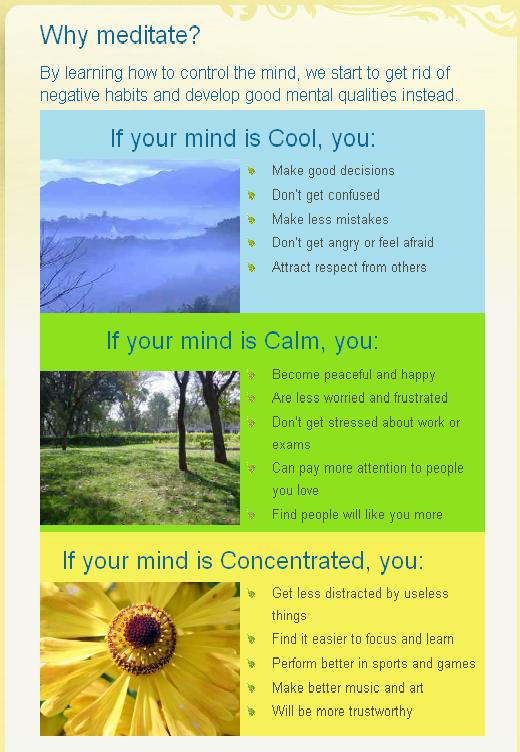
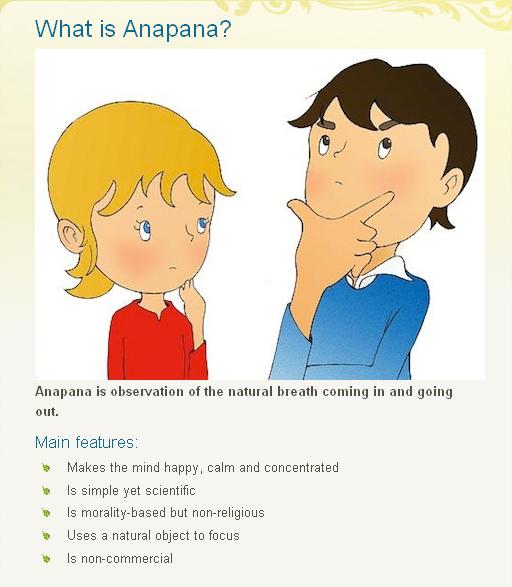

How meditation helps the mind
Q1. What is the mind?
The mind is what thinks! The mind can be helpful or harmful. If
the mind has poor habits, it will have negative feelings towards others.
If we make the effort to train the mind to improve itself, the thoughts
will be more good-natured and loving towards others and ourselves.
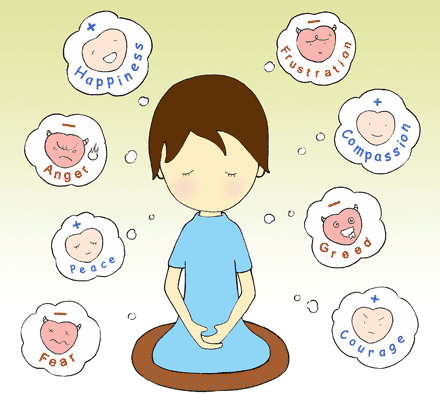
Q2. How can the mind improve?
The mind can purify itself. A part of the mind is always
observing what is happening and it can do the task of improving the
mind. If it learns to observe things as they are, then it will
understand that when there are negative thoughts or emotions, the mind
is distressed. As this observing part of the mind becomes stronger, the
reacting parts of the mind become weaker. The mind becomes more pure and
the suffering is removed.

Q3. How can Anapana meditation help?
You observe the breath coming in and going out, without allowing
any other thoughts. Usually when pleasant thoughts come in the mind, we
want something, and with unpleasant thoughts, there is dislike. But when
we are simply observing the breath, even for a few moments, there is
no negativity polluting the mind. As these moments of purity become
longer, the mind gradually becomes cleaner. It is initially at the
surface level, but this prepares you to later practice Vipassana
meditation, which will clean down to the roots.


Q4. How can we keep focused when the mind is full of thoughts?
That is exactly why we meditate. If the mind was already able to
stay focused, you would not need to meditate. The mind keeps wandering –
this is its habit. All kinds of thoughts come, mostly about the past or
the future. The important thing is how soon we become aware the mind
has wandered. Our job is to keep bringing the mind back to observing the
breath.
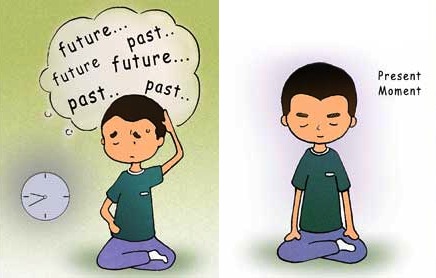
Q5. What is pure breath?
Pure breath is when there is only breath. The moment something
else, like a word or an image, is added to the breath it becomes impure.
In Anapana meditation, we work only with pure breath, nothing else
added.
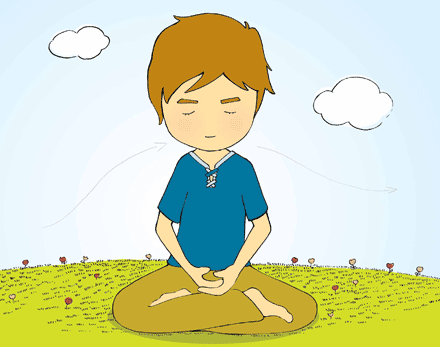
Q6. What is natural breath?
The flow of breath that happens naturally, without making any
extra effort. It may be soft or hard, slow or fast, but we never try to
change how it is. The natural breath comes in and goes out without any
effort on our part. Our job is just to observe it.

Q7. Why do we observe only the breath?
Because we want to know the truth about ourselves. By meditating
with only pure breath, and nothing else, we start to experience this
truth. Our breath is related to our body and also to our mind. We are
observing the breath, and in the process, we begin to know our mind.
When thoughts come in the mind, the mind reacts to these thoughts, and
the breath changes. When we get angry or upset, we notice that the
breath becomes harder and faster. As the mind calms down, the breath
returns to normal. As we understand the mind through observing the
breath, we are able to strengthen our good qualities.
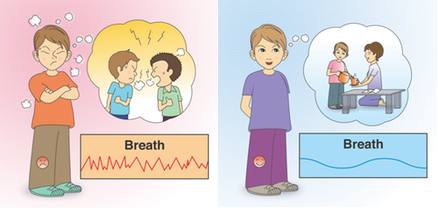
Q8. What are the qualities of a pure mind?
A pure mind is full of love, goodwill and compassion for
everyone. It does not generate anger, ill-will, hatred or greed. With a
pure mind, our thoughts and actions are kind and helpful to ourselves
and others.

Please watch:
http://www.youtube.com/watch?v=oLel1sMDpEM&list=LPWCeFjm-hYPo&index=1&feature=plcp
for Buddhist Meditation - Lama Ole Nydahl
05:11 mins
http://www.youtube.com/watch?v=-49FV0Bs6mw&list=LPWCeFjm-hYPo&index=2&feature=plcp
for Buddhas in Gardens - HD - Calming Nature Buddha Meditation -05:54 mins
http://www.youtube.com/watch?v=E2a5RZjzC8A&list=LPWCeFjm-hYPo&index=3&feature=plcp
for Buddhism, Meditation Nature & Water - Sublime,Inspiring Buddha Quotes HD Se- 04:08 mins
http://deoxy.org/annex/cwl.htm
http://www.thefullwiki.org/Meditation
http://savanatasisilasa.org/Thripitakaya.htm
|
|
| |

(Please
right
click
and
“save
target
as”
to
save
onto
your
computer)
We
added
these
great
electronic
version
of
thripitaka
books
to
this
site,
in
order
to
keep
all
under
one
umbrella
for
Savanata
Sisilasa
listners.
However,
this
wonderful
work
was
done
by
one
great
buddhist
friend
(Mr.
Ranasinghe).
Therefore,
every
time
you
download
these
dhamma
books
think
about
that
gentleman
and
pass
merits
to
him.

Meditation
Centres
in
Sri
Lanka
**********************
Kanduboda
Meditation
Centre
Delgoda
Tel.
011
445518
or
011
570306
Located
16
miles
from
Colombo,
accessible
by
bus
route
224
(Colombo/Pugoda).
Started
in
1956,
and
offers
Vipassana
instruction.
The
centre
can
accommodate
up
to
70
meditators
at a
time.
Accommodation,
meals
and
services
are
offered
free
of
charge,
the
centre
being
funded
by
donation.
Meditators
must
dress
in
white
throughout
their
stay
(White
clothing
is
available
for
foreigners).
Meditators
can
stay
for
a
number
of
weeks
or
months,
and
help
can
be
given
with
visa
extensions.
It
is
recommended
that
meditators
undergo
an
initial
training
period
of 3
weeks
at
the
centre.
Tuition
continues
throughout
the
year,
but
as
the
centre
can
be
full
at
times
(particularly
around
poya
days)
it
is
wise
to
telephone
ahead.
_____________________________________________________________
Na
Uyana
Meditation
Centre
Melsiripura
Chief
Incumbent:
Most
Ven.
Nauyane
Ariyadamma
NayakaThero
Telephone:
0375677328
_____________________________________________________________
Nilambe
Meditation
Centre
Nilambe,
Near
Kandy
Telephone
0777-804555
between
6pm
and
9pm
E-mail
address:
upulnilambe@yahoo.com
The
teacher,
until
his
death
in
March
2000,
at
this
centre
was
Godwin
Samararatne,
a
layman
with
extensive
experience
of
teaching
both
in
Sri
Lanka
and
abroad.
Godwin’s
style
was
firmly
within
the
Buddhist
tradition
but
with
an
emphasis
on
metta
(loving-kindness)
and
mindfulness
in
daily
life.
The
emphasis
at
the
centre
under
teacher
Upul
Gamage
continues
to
stress
these
aspects.
The
centre
is
in
beautiful
surroundings
above
a
tea
plantation
outside
of
Kandy.
Meditators
are
expected
to
adhere
to
the
outline
schedule:
On
Poya
(full
moon)
days
there
is
an
optional
Group
Meditation
through
the
night.
On
the
quarter
and
half
moon
days
there
is
an
optional
extended
Group
Meditation
until
midnight.
The
centre
is
easily
reached
by
bus
from
Kandy.
Buses
for
Galaha
pass
Nilambe
Office
Junction
(about
17km).
From
there
it
is a
steep
walk
(or
rickshaw
ride)
through
tea
plantations
to
reach
the
centre.
Alternatively,
taxis
or
autorickshaws
are
available
from
Kandy.
It
is a
good
idea
to
contact
the
centre
in
advance
to
let
them
know
when
you
will
be
arriving.
Advice
can
also
be
sought
from
the
Buddhist
Publication
Society
in
Kandy.
(Autorickshaws
are
often
available
from
the
bottom
of
the
office
junction,
at
Nilambe,
but
the
gate
half
way
up
the
tea
estate
road
is
locked
most
of
the
time.
You
can
try
calling
Nalaka
on
0777-811653
to
get
more
information,
or
to
get
the
gate
opened
in
the
non
meditation
times
if
you
cannot
walk
the
last
mile.)
Meditators
stay
from
one
night
to
several
years,
and
the
centre
can
help
long
term
meditators
with
visa
extensions.
Accommodation
at
the
centre
is
in
single
or
shared
rooms.
The
centre
has
no
electricity
supply,
and
conditions
are
adequate
but
basic.
Although
this
is a
lay
centre,
often
there
are
members
of
the
Sangha
undertaking
personal
retreats
at
Nilambe.
The
centre
charges
400
Sri
Lankan
rupees
per
day
(about
GBP
1.90
sterling,
USD
3.70
at
Feb
2007
rates)
to
foreigners
to
cover
accommodation
and
food.
Sri
Lankans
may
offer
donations
instead.
The
majority
of
longer-term
meditators
are
Westerners,
but
many
Sri
Lankans
also
use
the
centre
(particularly
around
Poya
days).
Teaching
is
available
in
English
and
Sinhala
from
the
resident
teachers.
There
is a
good
library
of
books
and
tapes
in
English
and
Sinhala.
________________________________________________________________
Dekanduwala
Meditation
Centre
Kananwila,
Kahatapitiya,
Horana
Inquiries
and
bookings
should
be
made
through:
Buddhist
Cultural
Centre,
125
Anderson
Road,
Nedimala,
Dehiwala.
This
is a
Vipassana
centre
catering
mainly
to
Sri
Lankan
meditators.
English
and
Sinhala
are
both
spoken
by
the
monk-in-charge,
and
foreign
meditators
are
welcome.
Transport
regularly
leaves
the
BCC
in
Dehiwala
(outskirts
of
Colombo)
to
go
to
the
meditation
centre,
and
the
BCC
should
be
able
to
arrange
an
interview
with
the
teacher
beforehand
should
this
be
required.
The
meditation
centre
is
also
accessible
by
bus
from
Colombo.
The
centre
is
under
the
direction
of
Ven.
K
Wimalajothi.
Chief
Incumbent:
Ven.
Uhumiya
Sumanasara
Thero
Telephone:
0344286334,
0112734256,
2728468
Email
:
BCC456@sltnet.lk
________________________________________________________________
Dhamma
Kuta
Mowbray,
Galaha
Road,
Hindagala,
Peradeniya
Tel:
08-234649
A
meditation
centre
which
follows
the
instruction
of
S.N.Goenka.
Regular
10
day
courses
in
Goenkaji’s
vipassana
method
take
place
at
the
centre.
Please
telephone
for
dates.
Instruction
is
with
the
aid
of
tapes,
and
assistant
teachers
are
in
attendence.
Goenka
follows
the
technique
introduced
by U
Ba
Khin
of
Burma.
After
instruction
in
Anapanasati
(mindfulness
of
breathing),
the
meditator
moves
on
to a
form
of
’sweeping’
meditation,
whereby
mindfulness
of
the
sensations
arising
and
ceasing
in
the
body
lead
to
an
understanding
of
anicca
(impermanance),
and
through
that
an
understanding
of
dukkha
and
anatta.
Instruction
is
available
in
Sinhala
and
English.
No
fees
are
charged,
donations
welcome.
See
dhamma.org
for
more
details
on
this
and
other
Goenka
centres
worldwide.
________________________________________________________________
Lewella
Meditation
Centre
160
Dharmasoka
Mawatha,
Lewella,
Kandy
Tel:
081-4921814
E-mail:
lewella.meditation@gmail.com
A
centre
for
experienced
male
meditators,
and
for
the
study
of
Buddhism,
situated
on
the
outskirts
of
Kandy.
In
addition
to
rooms
within
the
centre
several
individual
retreat
kutis
(huts)
are
available
on
the
edge
of
the
Udawattakelle
forest
reserve.
________________________________________________________________
Thalagala
Meditation
Centre
Horana
Chief
Incumben
:
Ven.
Uduwe
Hemaloka
Thero
Telephone
:
0342254206
________________________________________________________________
Madakada/
Nachchimale
Aranya
Senasanaya
MahaIngiriya
Ingiriya
Chief
Incumbent:
Ven.
Ampitiye
Sumangala
________________________________________________________________
Dhamma
Sobha
Vipassana
Meditation
Centre
Kosgama
Telephone:
0362253955
Emai
:
dhammasoba@yahoo.com
________________________________________________________________
Dhammakuta
Vipassana
Meditation
Centre
Hindagala,
Peradeniya
Telephone:
0812385774
Email:
dhamma@sltnet.lk
________________________________________________________________
Sri
Dalada
Thapowanaya
Udawatte
Kele
Kandy
Telephone:
0812225052
________________________________________________________________
Siyane
Vidarshana
Meditation
Centre
Kandubod,
Delgoda
Telephone:
0112445518,
257030
________________________________________________________________
Sumathipala
Nahimi
Aranya
Senasanaya
Kanduboda,
Delgoda
Telephone
:
0112402805
________________________________________________________________
Meethirigala
Nissarana
Wanaya
Meethirigala
Telephone:
0602339193
Web:
www.lewellameditation.org
________________________________________________________________
Nimalawa
Aranya
Senasanaya
Tissamaharama
Chief
Incumbent
:
Most
Ven.
Welimada
Dhammadassi
Nayaka
Thero
Telephone
:
0115734075
May
attain
your
Nibbana
!!!

|
|
VOICE OF SARVA SAMAJ
Construction of flyover near Mayawati’s residence started
Lucknow: Work has started
on a flyover at Mall Avenue here, which had raised the hackles of BSP
supremo Mayawati as it would pass near her residence and party office.
The flyover, to be constructed by Uttar Pradesh Bridges Corporation at
an estimated cost of Rs 40 crore, would be 15 m wide, 650 m long and
would be completed in 15 months, official sources said here.
The state government had proposed to construct the flyover in its annual budget.
During a post-budget press conference, UP Chief Minister Akhilesh Yadav
had said that a large number of bridges were being constructed in the
state.
“If anything comes in the way, even then flyover will be constructed,
route will not be changed. Crossing is also there,” he said.
Taking strong exception to the proposal to build the flyover on the road
facing the party headquarters here, BSP member and Leader of Opposition
Swami Prasad Maurya had termed it as “politically motivated”.
“If there is really a need to ease the traffic, an overbridge should
first come up on Vikramaditya Marg which has the residence of SP chief
Mulayam Singh Yadav and also has SP office,” Maurya had said.
“The government should first worry about the traffic jam on the
Vikramaditya Marg before thinking about Loreto Convent-Telibagh route
(on the road facing the BSP office)… If they do not do so, it would
mean that they have wrong intentions for which they would have to pay a
heavy price later,” he had said.
SP govt have wrong intentions which means BSP is treading the right path and SP the wrong path which will certainly bring them down.


A trio of daredevil
musicians known as Led Zipline have taken to the skies for jamming sessions -
dangling 1,000ft above a French gorge. Above, Armin Holzer plays the didgeridoo
while Mich Kemeter relaxes in a hammock hanging on a highline 300m above the
River Verdon in France.
Food as Medicine
HAY FEVER? EAT YOGURT!
Eat lots of yogurt before pollen season.
Also-eat honey from your area (local region) daily.
TO PREVENT STROKE DRINK TEA!
Prevent build-up of fatty deposits on artery walls with regular doses
of tea. (actually, tea suppresses appetite and keeps the pounds from
invading….Green tea is great for our immune system)!
INSOMNIA (CAN’T SLEEP?) HONEY!
Use honey as a tranquilizer and sedative.
ASTHMA? EAT ONIONS!!!!
Eating onions helps ease constriction of bronchial tubes. (onion packs
place on chest helped the respiratory ailments and actually made
breathing better).
ARTHRITIS? EAT FISH, TOO!!
Salmon, tuna, mackerel and sardines actually prevent arthritis. (fish
has omega oils, good for our immune system)
UPSET STOMACH? BANANAS - GINGER!!!!!
Bananas will settle an upset stomach.
Ginger will cure morning sickness and nausea..
BLADDER INFECTION? DRINK CRANBERRY JUICE!!!!
High-acid cranberry juice controls harmful bacteria.
BONE PROBLEMS? EAT PINEAPPLE!!!
Bone fractures and osteoporosis can be prevented by the manganese in pineapple.
MEMORY PROBLEMS? EAT OYSTERS!
Oysters help improve your mental functioning by supplying much-needed zinc.
COLDS? EAT GARLIC!
Clear up that stuffy head with garlic. (remember, garlic lowers
cholesterol, too.)
COUGHING? USE RED PEPPERS!!
A substance similar to that found in the cough syrups is found in hot
red pepper. Use red (cayenne) pepper with caution-it can irritate your
tummy.
BREAST CANCER? EAT Wheat, bran and cabbage
Helps to maintain estrogen at healthy levels.
LUNG CANCER? EAT DARK GREEN AND ORANGE AND VEGGIES!!!
A good antidote is beta carotene, a form of Vitamin A found in dark
green and orange vegetables.
ULCERS? EAT CABBAGE ALSO!!!
Cabbage contains chemicals that help heal both gastric and duodenal ulcers.
DIARRHEA? EAT APPLES!
Grate an apple with its skin, let it turn brown and eat it to cure
this condition. (Bananas are good for this ailment)
CLOGGED ARTERIES? EAT AVOCADO!
Mono unsaturated fat in avocados lowers cholesterol.
HIGH BLOOD PRESSURE? EAT CELERY AND OLIVE OIL!!!
Olive oil has been shown to lower blood pressure.
Celery contains a chemical that lowers pressure too.
BLOOD SUGAR IMBALANCE? EAT BROCCOLI AND PEANUTS!!!
The chromium in broccoli and peanuts helps regulate insulin and blood sugar.
Kiwi: Tiny but mighty. This is a good source of potassium, magnesium,
Vitamin E fibre. It’s Vitamin C content is twice that of an orange.
Apple: An apple a day keeps the doctor away? Although an apple has a
low Vitamin C content, it has antioxidants flavonoids which enhances
the activity of Vitamin C thereby helping to lower the risks of colon
cancer, heart attack stroke..
Strawberry: Protective fruit. Strawberries have the highest total
antioxidant power among major fruits protects the body from cancer
causing, blood vessels clogging free radicals. (Actually, any berry is
good for you..they’re high in anti-oxidants and they actually keep us
young………..blueberries are the best and very versatile in the
health field……..they get rid of all the free-radicals that invade
our bodies)
Orange : Sweetest medicine. Taking 2 - 4 oranges a day may help keep
colds away, lower cholesterol, prevent dissolve kidney stones as well
as lessen the risk of colon cancer..
Watermelon: Coolest Thirst Quencher. Composed of 92% water, it is also
packed with a giant dose of glutathione which helps boost our immune
system.. They are also a key source of lycopene - the cancer fighting
oxidant. Other nutrients
Found in watermelon are Vitamin C Potassium.(watermelon also has
natural substances [natural SPF sources] that keep our skin healthy,
protecting our skin from those darn UV rays)
Guava Papaya: Top awards for Vitamin C. They are the clear winners for
their high Vitamin C content. Guava is also rich in fibre which helps
prevent constipation.
Papaya is rich in carotene, this is good for your eyes. (also good for
gas and indigestion)
Tomatoes are very good as a preventative measure for men, keeps those
prostrate problems from invading their bodies……GOOD AS MEDICINE..
17 Reasons Why You Need a Mango Every Day ~
1. Fights cancer
2. Keeps cholesterol in check
3. Skin cleanser
4. Alkalizes the body
5. Weight loss
6. Regulates diabetes
7. Aphrodisiac
8. Eye care
9. Helps in digestion
10. Heat stroke
11. Strengthens your immune
12. Body scrub
13. Aids concentration and memory
14. High iron for women
15. Reduces Kidney Stones
16. Perfect Snack
17. Stomach Tonic
![]() and 10) When
and 10) When
